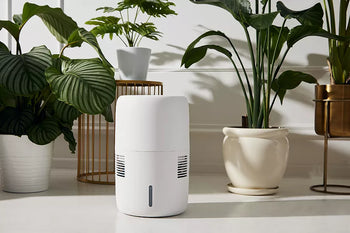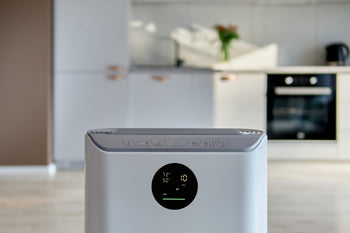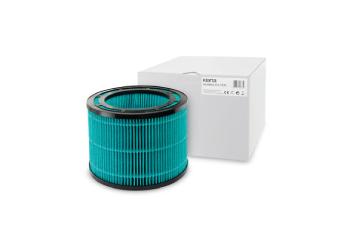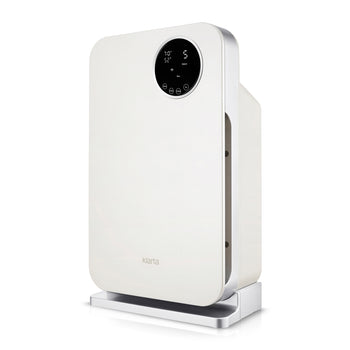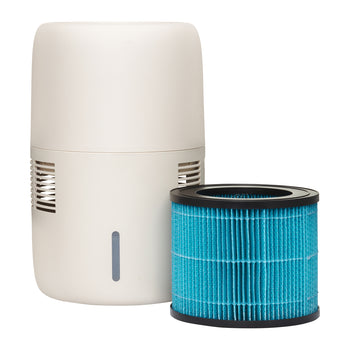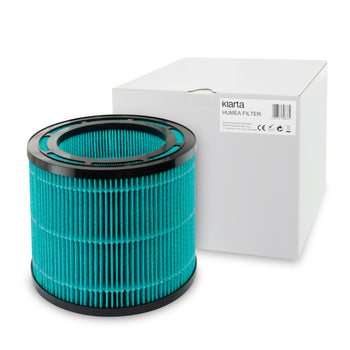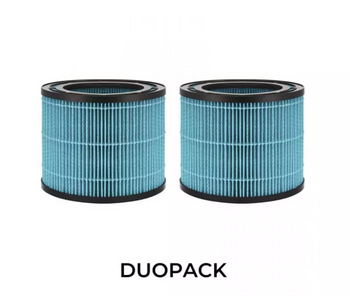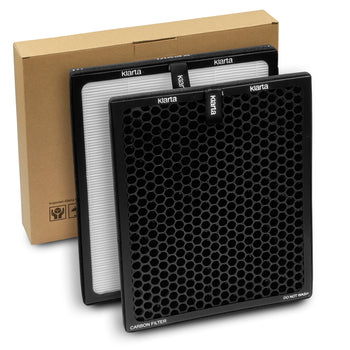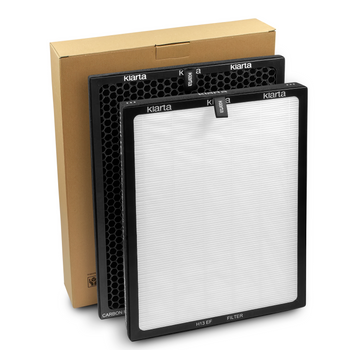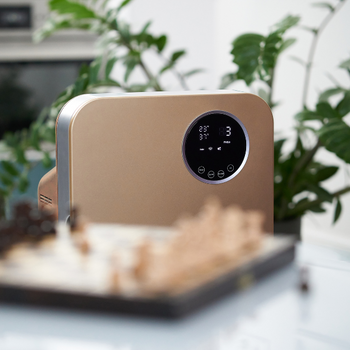
Health-Conscious Technology Every Office Space Should Have
Poor indoor air quality can lead to dry, burning nose and throat mucus membranes, hawking and hoarseness, skin irritation and efficiency and concentration decrease in general. The so-called sick building syndrome (SBS), often resulting from building materials and indoor human activities, affects up to 57 % offices (according to research conducted in 2022). Klarta’s air purifiers and humidifiers will help you monitor particulate matter, temperature and humidity levels.
Why healthy working conditions are so important?
Poor indoor air, whether stuffy, overly dry, or contaminated with pollutants, can leave employees feeling tired, unfocused, and even unwell. Over time, this can lead to more sick days, higher turnover, and a noticeable dip in productivity.
On the other side, clean, fresh and properly humidified air supports concentration and creativity, positively impacts mood and work satisfaction rate.
It manifests in Berkeley’s scientists research, where cognitive tests were taken by employees working in optimal humidity and temperaturę levels and those, who were working in suboptimal conditions. It turned out that simple maintenance of proper temperature and humidity levels enabled to achieve 5.4% better results.
-
Decreasing pollution level enabled to additionally elevate the effectivity up to 10%
-
Up to 35% less absences
-
Higher revenues–according to Harvard’s professor, Joseph Allen, better air quality can bring up to $6,500 per year.
Combat dry, foul air with Klarta air purifiers and humidifiers
Combining impressive efficiency, superior air-quality assessment system, sensitive sensors and capacious filters, Klarta’s smart devices safeguard your indoor air quality.
Along with low-cost exploitation and quiet operation, they seem a perfect match for office environment.
How Klarta’s air purifiers can enhance your workplace air quality?
-
Reduce dust mites and other allergens
Inhalant allergens can cause respiratory tract issues, such as nasal congestion, throat irritation, and chronic postnasal drip.
-
Eliminate smog particulate matter and traffic pollution
Smog contains suspended particulate matter — PM1, PM2.5, and PM10, in which you can find particles of heavy metals and polycyclic aromatic hydrocarbons (PAHs). Apart from them, sulfur and nitrogen oxides can also be found there.
Hence, even short-term exposure to smog can irritate the respiratory system or worsen cardiovascular conditions. Long-term exposure increases the risk of various health issues, including lung and laryngeal cancers.
-
Remove bad odors and harmful volatile organic compounds
Volatile Organic Compounds (VOCs) are a group of carbon-containing compounds that are characterized by their ability to easily transition into vapor or gas form. Some of them, such as formaldehyde, benzene, and toluene, have toxic properties.
Proven filtration system with HEPA-like H13 EF at its heart
Equipped with HEPA-like filters, Klarta Forste and Klarta Stor relentlessly remove particulate matter, the most elementary smog component, being equally uncompromising for all inhalant allergens: dust mites, mold spores, plant pollen, and pet dander, as well as bacteria and viruses.
Active carbon filtration adsorbs harmful gases, including formaldehyde and nitrogen oxides. Therefore both filters complement each other
3 x Auto Mode in Air Purifiers
Take advantage of the highly precise automatic modes. Simply turn on the purifier, select Auto Silent, Auto Normal, or Auto Turbo mode, and get back to your usual duties.
A carefully designed, rigorous algorithm automatically adjusts the purification speed to the current air conditions, responding to PM2.5 levels as low as 6 µg/m3.
Robust efficiency, well-suited for large surfaces
Boasting with CADR reaching up to 353 ft3/min, Klarta Stor is a perfect choice for larger rooms, reaching even 860 ft2.
For smaller areas, choose Klarta Forste, a compact model providing performance of 177 ft3/min, designed for 430 ft2.
How Klarta’s air humidifiers can enhance your workplace air quality?
-
Less respiratory tract infections
Dry air results in dryness of mucous membranes, covering respiratory tracts. As a result, the cilia in the nasal epithelium, responsible for filtering inhaled air, loses its natural resilience and elasticity, being unable to expel viruses and bacteria entering our body.
-
Reduced moisture loss
In environments with low humidity, the skin is more prone to dryness as water evaporates from the epidermis. Transepidermal water loss (TEWL) is a natural process where water moves through the skin and evaporates from the surface.
Excessive moisture loss is not desirable, though, as it can lead to dryness, which in turn causes various skin issues.
-
Decrease the amount of microparticles
Humidity control as a way to purify the air in the home? As unbelievable as it may sound, the humidity level and air cleanliness are quite strongly related.
In humid air, mold and dust mites thrive, while dry air carries more dust. Therefore, it's important to maintain a humidity level of 40-60%. A good humidifier can help achieve this.
Evaporative filtration, safe and hygienic for you and your environment
Using the natural method of cool evaporation, where water is filtered and then stripped of dust and mineral compounds, Klarta Humea WiFi provides moisture in a form of cool, invisible mist that does not harm your respiratory tract or surrounding subjects.
A hygrometer and hygrostat in the air humidifier for better control of humidity levels
Thanks to its inbuilt hygrometer, Klarta Humea WiFi reads precisely current humidity level in the environment.
Its humidistat, on the other hand, allows to set a target, comfortable humidity level. Vital as it is, humidity levels in office buildings often drop even below 25-30 %, while the optimal range of relative humidity is considered to be between 40-60%.
Set one of the predefined moisture levels and Humea WiFi will do the rest, .
Impressive humidifying efficency
Characterized by performance reaching 300 ml per hour, Klarta Humea WiFi is well-suited for areas up to 475 ft2.
What other technologies can promote workplace health?
As stated above, air quality directly influences your wellbeing, increasing or decreasing the number of factors that can irritate or distract. What other steps can you take to improve the quality of your workplace?
Properly working, serviced HVAC system
HVAC systems maintain comfortable temperatures, preventing heat stress and cold-related illnesses. Equipped with filters, they also remove pollutants, e.g. dust mites and particulate matter, when providing air circulation. The mechanism is similar to air purifiers work.
It results in a cleaner and healthier office environment, reducing the risk of respiratory illnesses.
Have in mind two vital aspects, though. Air conditioning can genuinely maintain comfortable temperature level, but it decreases humidity, even below the recommended level of 40%. It might be necessary to invest in air humidifier to even the moisture.
Moreover, it is also crucial to regularly service the ventillation system. Moisture recuperated from air accumulates within the unit – particularly on the evaporator and other components. This creates ideal conditions for the development of bacteria, viruses, fungi, and mold.
Therefore, it is important to regularly, once per year, fumigate the air conditioning system.
Light exposure – smart lighting
Light, especially natural one, not only brigthens the space, but supports eye health, reducing its fatigueness. Exposure to daylight can help prevent vitamin D deficiency and reduce the risk of seasonal affective disorder (SAD).
Therefore, when choosing a place for your home office, take a look at its insolation. Larger windows or skylights can be a pros here.
In bureau environment, try to introduce smart lighting, which automatically identifies the optimum lighting settings for any given space, without distracting you from your tasks.
Vacuum Cleaner with a HEPA Filter
Dust on furniture and floors can easily become airborne, which is why regular cleaning is essential. The best way to do this is by using a vacuum cleaner equipped with a HEPA filter.
It prevents even the finest particles — including allergens and suspended dust — from being released back into the air.
Sources:
1. Wang, M.; Li, L.; Hou, C.; Guo, X.; Fu, H. ”Building and Health: Mapping the Knowledge Development of Sick Building Syndrome”. Buildings 2022, 12, 287. https://doi.org/10.3390/buildings12030287. Access to website: 25.09.2023.
